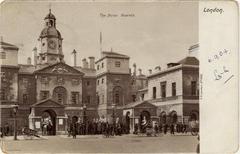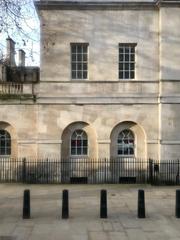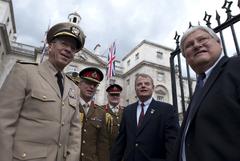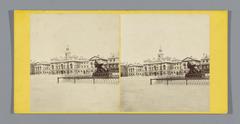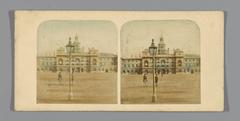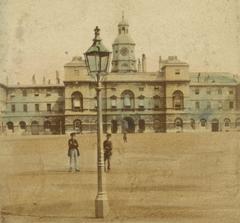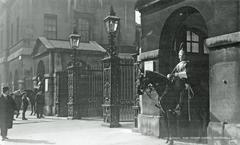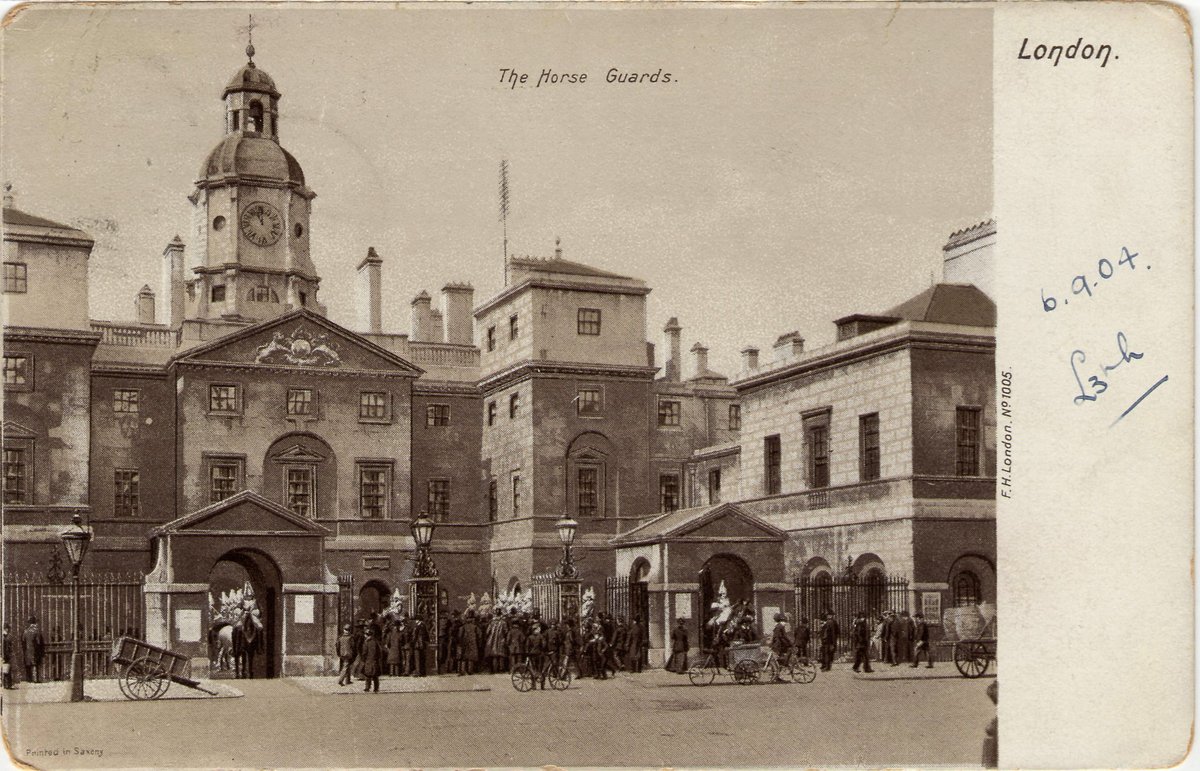
Horse Guards London: Visiting Hours, Tickets, and Historical Significance Guide
Date: 14/06/2025
Introduction
Horse Guards, located in the heart of Westminster, stands as a distinguished symbol of British royal heritage and military tradition. Positioned between Whitehall and St James’s Park, this historic landmark serves as both the headquarters of the Household Cavalry and the ceremonial gateway to the royal palaces. Horse Guards is renowned for its striking 18th-century architecture, vibrant ceremonial displays, and its enduring role in state occasions such as the Changing of the King’s Life Guard and Trooping the Colour.
This guide provides a comprehensive overview of Horse Guards’ fascinating history, detailed visitor information (including opening hours, ticketing, accessibility, and travel tips), and highlights of its most significant ceremonies and events. Whether you are a history enthusiast or a first-time visitor to London, this resource ensures you can experience Horse Guards to the fullest.
For up-to-date ceremony schedules, ticket bookings, and virtual tours, consult official sources such as the Household Division website, Changing the Guard, and Strawberry Tours.
Table of Contents
- Introduction
- Historical Background
- Visiting Horse Guards: Practical Information
- Ceremonial and Cultural Significance
- Practical Visitor Tips
- Preservation and Public Engagement
- Summary and Travel Recommendations
- References
Historical Background
Tudor Tiltyard Origins
Horse Guards occupies a site steeped in royal history. In the 16th century, it was the tiltyard of Whitehall Palace, hosting lavish jousting tournaments and martial displays for the Tudor court (British History Online). The area was a focal point of pageantry, as noted by contemporary accounts and period maps. Tournaments continued through the Stuart period, with the last recorded event in 1663.
17th Century: From Tiltyard to Guardhouse
Political unrest in the mid-17th century led to the creation of a Court of Guard at Whitehall in 1641. A permanent Guard House was built in 1649, surviving the Commonwealth and expanded after the Restoration of Charles II (British History Online). The growing ceremonial and security demands saw the construction of larger facilities by 1664, cementing the association between the site and the Household Cavalry.
18th Century Rebuilding and Architectural Significance
By the early 18th century, the original guard buildings had deteriorated. In 1745, King George II commissioned a new Horse Guards building, designed by William Kent. Construction began in 1750 and was completed in 1760, featuring a central clock tower, two flanking wings, and a grand archway connecting Whitehall to St James’s Park (Londondrum). This design established the ceremonial grandeur that defines Horse Guards today.
Ceremonial and Military Headquarters
Horse Guards quickly became the headquarters of Britain’s senior army regiments and the ceremonial gateway to the royal palaces. After Whitehall Palace’s destruction in 1698, the focus of royal residence shifted, but Horse Guards retained its pivotal role guarding ceremonial approaches to St James’s and later Buckingham Palace (Londondrum). The adjacent parade ground, once a tiltyard, now hosts major state events, including Trooping the Colour.
Today, the complex also houses the Household Cavalry Museum, offering visitors insight into the regiment’s storied past and daily routines (Londondrum).
Visiting Horse Guards: Practical Information
Location and Access
Horse Guards is centrally located at Whitehall, London SW1A 2AX, between Whitehall and St James’s Park. It is within walking distance of major landmarks such as Buckingham Palace, Trafalgar Square, and Westminster Abbey (Strawberry Tours).
Public Transport:
- Nearest Underground Stations: Westminster, Charing Cross, Embankment (all within a 10-minute walk).
- Rail: Charing Cross Station.
- Buses: Multiple routes serve Whitehall, including 3, 11, 12, 24, 53, 87, 88, 159, 453 (Changing Guard).
- Car: Driving is discouraged due to congestion charges and limited parking; the nearest car park is near Trafalgar Square (Strawberry Tours).
Opening Hours:
- Parade ground gates: Open daily from 7:00 to 20:00 (freetoursbyfoot.com).
- General visiting hours: 10:00–16:00 for most visitor activities.
Tickets and Entry
- Parade Ground & Ceremonies: Free entry; no tickets required for daily ceremonies or to walk through the parade ground.
- Household Cavalry Museum: Tickets required (£10 adults, £8 concessions). Advance booking is recommended during peak periods (Strawberry Tours).
Accessibility
- The site is wheelchair and stroller accessible, with ramps and accessible restrooms at the museum.
- Assistance dogs are welcome.
- During major events, accessible viewing areas are available but may require advance booking (trooping-the-colour.co.uk).
Special Events and Guided Tours
- Trooping the Colour: Annual celebration of the Sovereign’s official birthday in June, requiring advance ticket application (Household Division).
- Beating Retreat: Musical pageantry event in July; ticketed.
- Guided Tours: Available through the Household Cavalry Museum and select walking tour providers (Strawberry Tours).
Nearby Attractions
- St James’s Park (adjacent)
- Buckingham Palace (10-minute walk)
- Trafalgar Square (5-minute walk)
- Westminster Abbey and Big Ben (10–15-minute walk)
Ceremonial and Cultural Significance
Trooping the Colour
Held each June, Trooping the Colour marks the official birthday of the British Sovereign. The ceremony involves over 1,350 soldiers, 200 horses, and 300 musicians, with the King inspecting the troops and a Royal Air Force flypast closing the event (British Army; iNews).
Beating Retreat
This evening event features massed military bands, drummers, and the Mounted State Trumpeters. The ceremony, rooted in 17th-century tradition, includes the lowering of the regimental flag and is attended by senior royals (Trooping the Colour - Beating Retreat).
Daily Ceremonies
- Changing of the King’s Life Guard:
- Monday–Saturday: 11:00
- Sunday: 10:00
- New Guard departs Hyde Park Barracks at 10:28 (9:28 on Sundays)
- Ceremony is free and lasts around 30 minutes (freetoursbyfoot.com; plantriplondon.com)
- Dismount Parade: 16:00 daily (also known as the Four O’Clock Parade or Punishment Parade)
- Mounted Sentries: Change hourly until 16:00
Symbolism and National Identity
The ceremonies at Horse Guards Parade symbolize the honor, discipline, and continuity of British national identity. The regimental Colours, precision of the drills, and royal presence reinforce the historic relationship between the monarchy, military, and the public (British Army).
Visual and Interactive Resources
- Official websites offer virtual tours and galleries: Household Division
- Maps and ceremony schedules are available to enhance planning (Changing Guard)
Practical Visitor Tips
Best Times to Visit
- Arrive 30–45 minutes early for ceremonies, especially during peak tourist seasons or special events (Strawberry Tours).
- Weekday mornings tend to be less crowded.
Photography and Visitor Conduct
- Photography is permitted; avoid flash and do not touch the guards or horses.
- Stay behind white safety lines and follow posted instructions.
Safety, Accessibility, and Comfort
- Dress for the weather; ceremonies are held outdoors in most conditions.
- There are no public restrooms or cafés on-site; use facilities in St James’s Park or nearby.
- The site is family-friendly but supervise children, especially near horses.
- Security checks may be conducted during major events.
Frequently Asked Questions (FAQ)
Q: Are tickets required to watch ceremonies at Horse Guards?
A: No, daily ceremonies and parade ground access are free. Tickets are required for the Household Cavalry Museum and major events like Trooping the Colour.
Q: What are the Horse Guards visiting hours?
A: Gates open 7:00 to 20:00; most visitor activities run 10:00 to 16:00.
Q: Is Horse Guards accessible for wheelchair users?
A: Yes, the site is wheelchair accessible with designated viewing areas during major events.
Q: Can I take photos with the guards?
A: Yes, but do not touch the guards or horses.
Q: Where can I find ceremony schedules and updates?
A: Check the official Household Division website and Changing the Guard.
Preservation and Public Engagement
Horse Guards remains remarkably well-preserved, ensuring visitors enjoy both historical authenticity and modern accessibility. The building’s iconic clocktower and daily ceremonies continue to draw large crowds. The site is a living museum—part of everyday British life, military discipline, and national celebration (Londondrum).
Summary and Travel Recommendations
Horse Guards offers an unparalleled glimpse into Britain’s royal and military heritage. With free access to the parade ground, engaging daily ceremonies, and a rich museum experience, it is a highlight for any visitor to London. Its central location makes it easy to combine with nearby attractions like Buckingham Palace and St James’s Park.
For the latest updates on events, tickets, and accessibility, use trusted sources such as the Household Division website and Changing the Guard. Download the Audiala app for guided tours, insider tips, and live updates.
Horse Guards is a living testament to Britain’s ceremonial and historical legacy—be sure to include it in your London itinerary!
References
- British History Online
- Londondrum
- Guide London
- Free Tours by Foot
- Wandertoes
- British Army
- iNews
- Trooping the Colour - Beating Retreat
- Strawberry Tours
- Changing Guard
- AllTrippers
- Plan Trip London
